Legislation empowers us to do research so we can better understand and adapt to a changing ocean.
Legislation, strategies, and plans guide how we put research dollars to work answering our most pressing questions about ocean acidification.

Guiding Legislation & Program Drivers
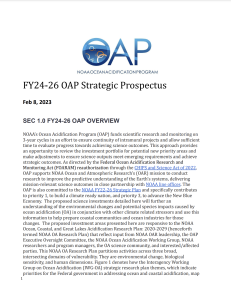

OAP Strategic Prospectus
NOAA’s Ocean Acidification Program funds scientific research and monitoring on 3-year cycles. This provides sufficient investment and time to evaluate progress towards science outcomes. This strategic prospectus provides transparency on the priorities and investments during fiscal year 2024-2026.
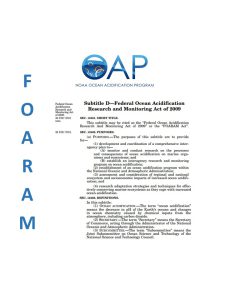

The FOARAM Act
The Federal Ocean Acidification Research and Monitoring Act (FOARAM; 33 U.S.C. Chapter 50, Sec. 3701-3708) was passed by Congress in 2009. This legislation allowed for the establishment of NOAA’s Ocean Acidification program.
The act outlined a coordinated process for federal agencies to create a plan for effective monitoring of processes and consequences of ocean and coastal acidification on marine organisms and ecosystems through the creation of an Interagency Working Group on Ocean Acidification. Also included in this legislation is the requirement to develop adaptation strategies to conserve ecosystems (both at regional and national levels) vulnerable to the effects of acidification, and the associated socio-economic impacts.
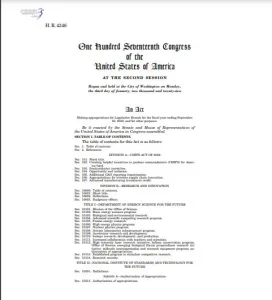

The CHIPS and Science Act of 2022
The CHIPS and Science Act of 2022 makes historic investments that will strengthen American manufacturing, supply chains, and national security, and invest in research and development, science and technology, and the workforce.
Section E of this bipartisan law provides investment and federal mandates for coastal and ocean acidification research and innovation, It reauthorizes the FOARAM Act of 2009 and ascribes additional responsibilities to NOAA and other federal agencies. More on the purpose of the law.
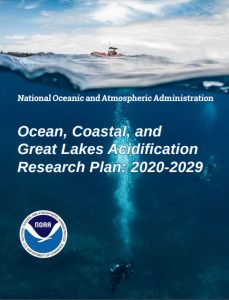

NOAA Ocean & Great Lakes Acidification Plan
The 2020 NOAA Ocean, Coastal, and Great Lakes Acidification Research Plan guide’s NOAA’s research efforts across the U.S.
The Plan provides the rationale for the NOAA Ocean Acidification Program, the research, resources, and includes relevant ocean acidification issues in each of the six regions in the U.S (including the West Coast, Pacific Islands, Southeast Atlantic and Gulf of Mexico., Northeast, and Great Lakes). The original NOAA Ocean and Great Lakes Acidification Research Plan was written by the NOAA Ocean Acidification Steering Committee and published in April 2010. It outlines how to approach the goals laid out in the FOARAM Act.
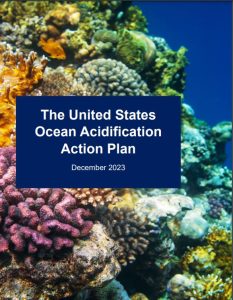

The United States Ocean Acidification Action Plan
The United States Ocean Acidification Action Plan (U.S. OA Action Plan) was produced by the National Oceanic and Atmospheric Administration and the Department of State on behalf of the U.S. Government.
The United States joined the International Alliance to Combat Ocean Acidification (OA Alliance) in 2022 and committed to writing this plan in fulfillment of the membership requirements of the OA Alliance and as a commitment in the Biden-Harris Administration’s Ocean Climate Action Plan. Ocean acidification action plans detail actions that OA Alliance members will take to better understand the impacts of acidification in their region and accelerate mitigation, adaptation, and resilience efforts.
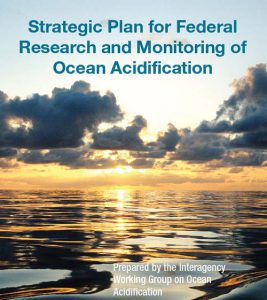

Strategic Plan for Federal Research & Monitoring
The Strategic Plan for Federal Research and Monitoring was written by the Interagency Working Group on Ocean Acidification, and published in March 2014. It provides a thoughtful and strategic approach to understand and address the rapidly emerging problem of ocean acidification.
It’s intended to guide federal ocean acidification investments and activities over the next decade and beyond. It will provide a better understanding of the process of ocean acidification, its effects on marine ecosystems, and the steps that must be taken to minimize harm from ocean acidification. Seven priority areas were identified.
- Research,
- Monitoring,
- Modeling,
- Technology development,
- Socioeconomic impacts,
- Education and outreach and
- Data management.


State of the Science
The 2016 Ocean Acidification State of the Science Fact Sheet provides a summary of NOAA's efforts to address ocean acidification. NOAA manages a cutting-edge science program focused on research with a high relevance to society.
To assist the general public in understanding the state of the science, NOAA develops State of the Science Fact Sheets about key research areas of high public interest. The NOAA Research Council oversees the creation and updating of these fact sheets, and the most recent documents are posted here for the public.
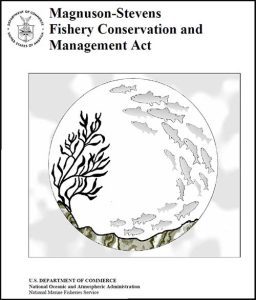

The Magnuson-Stevens Act
The Magnuson-Stevens Act promotes responsible conservation and management of fishery resources. It was first enacted in 1996 and later revised and re-authorized in 2007.
Since acidification can impact both the growth and physiology of fishes, understanding and mitigating these impacts is critical to one of the purposes of this act, which is to foster and maintain the diversity of fisheries in the United States.
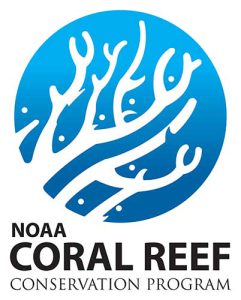

Coral Reef Conservation Program - Ocean Acidification Science Plan
NOAA's Coral Reef Conservation Program (CRCP) created a science plan to approach Ocean Acidification and its implications for coral reefs.
It outlines a national approach to conduct the research needed to address the numerous management challenges for reducing threats, reversing declines and promoting the resilience of coral reef ecosystems with regards to Ocean Acidification.
NOAA's Mission
To understand and predict changes in climate, weather, oceans, and coasts, to share that knowledge and information with others, and to conserve and manage coastal and marine ecosystems and resources.
NOAA is an agency that enriches life through science. Our reach goes from the surface of the sun to the depths of the ocean floor as we work to keep citizens informed of the changing environment around them. From daily weather forecasts, severe storm warnings, and climate monitoring to fisheries management, coastal restoration and supporting marine commerce, NOAA’s products and services support economic vitality and affect more than one-third of America’s gross domestic product. NOAA’s dedicated scientists use cutting-edge research and high-tech instrumentation to provide citizens, planners, emergency managers and other decision makers with reliable information they need when they need it.


